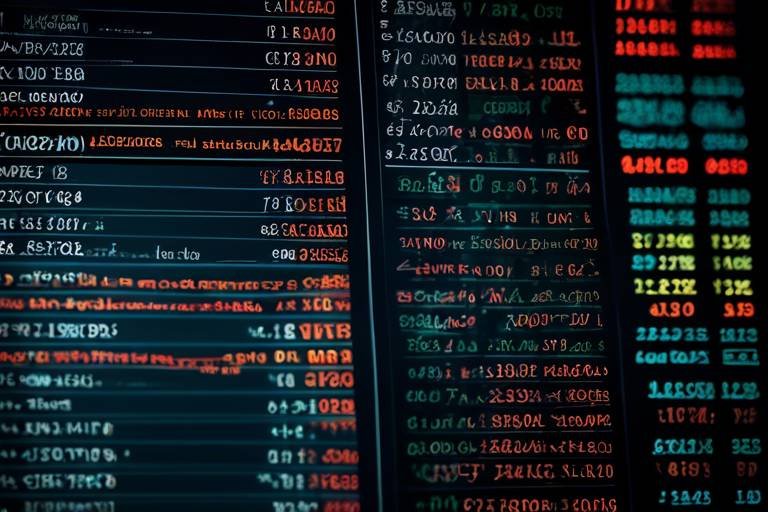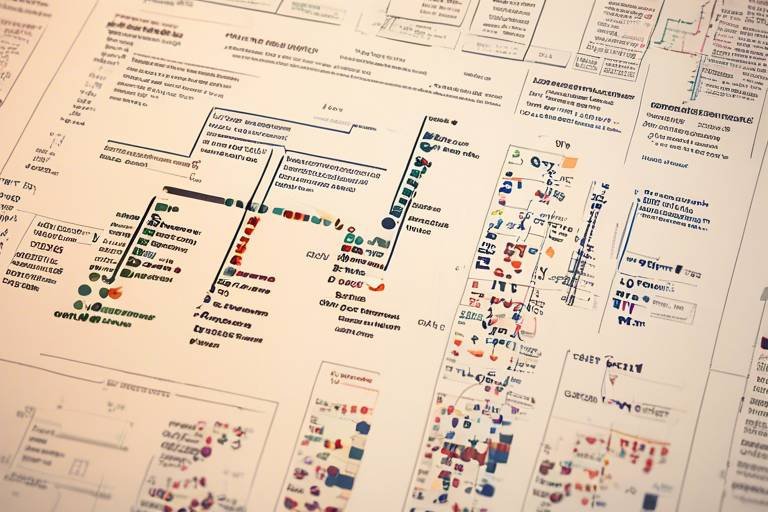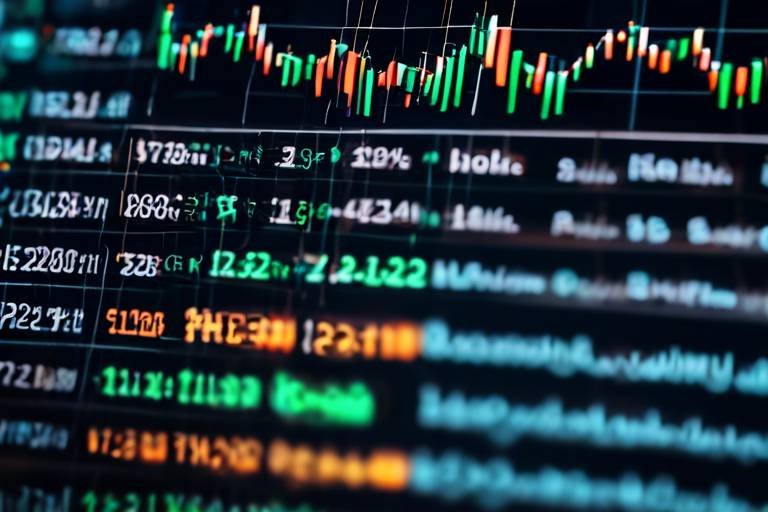How to Analyze the Effectiveness of Your Trading Techniques
In the fast-paced world of trading, understanding how to analyze the effectiveness of your trading techniques is crucial. It’s like being a chef who constantly tastes their dishes; without that feedback, you might end up serving something bland. The right analysis can help you identify what’s working, what’s not, and how to refine your approach for better results. So, how do you go about this? Well, it starts with a thorough understanding of performance metrics, backtesting strategies, and the psychological aspects that influence your decisions.
Performance metrics are the backbone of evaluating trading strategies. Think of them as your trading report card. They provide a quantifiable way to measure your success and pinpoint areas that need improvement. Key indicators such as Return on Investment (ROI), win rate, and drawdown are essential for this analysis. For instance, a high ROI indicates that your trades are profitable, while a high win rate shows that you’re making the right calls more often than not. However, it’s also vital to keep an eye on drawdown, which measures how much your account has fallen from its peak. If drawdown is too high, it could signal that you need to reassess your risk management strategies.
Backtesting is like rehearsing for a performance; it allows traders to simulate their strategies using historical data before risking real money. By analyzing past market conditions, you can determine how your strategies would have performed. But here’s the kicker: backtesting isn’t just about running numbers; it’s about interpreting those results to refine your techniques effectively. Are you ready to dive deeper into this? Let’s break it down further.
Selecting the appropriate historical data is crucial for accurate backtesting. Imagine trying to solve a puzzle with missing pieces; it just won’t work! You’ll want to consider various types of data, including different timeframes and asset classes. For example, if you’re trading stocks, you might want to look at daily, weekly, and monthly data to see how your strategy holds up across different time periods. This comprehensive approach ensures reliable analysis and helps you create a robust trading strategy.
High-quality data is vital for effective backtesting. Using inaccurate or incomplete data can lead to misleading results, which is like building a house on a shaky foundation. To avoid this pitfall, ensure that your data sources are reputable and that the information is up-to-date. Remember, the integrity of your data directly influences the reliability of your backtest results, so don’t skimp on this crucial step!
Simulating realistic market conditions during backtesting is essential. You wouldn’t train for a marathon on a treadmill set to a flat surface, right? Similarly, replicating market volatility and liquidity is necessary for a more accurate assessment of your strategies. Various techniques can help you achieve this, such as incorporating slippage and transaction costs into your models. By doing so, you’ll get a clearer picture of how your trades might perform in real-world scenarios.
Now, let’s talk about the mind game of trading. Psychological factors play a significant role in trading effectiveness. Emotions like fear and greed can cloud your judgment and lead to impulsive decisions. Have you ever made a trade you regretted later? That’s the psychological aspect rearing its head. Understanding how your emotions and biases impact your trading decisions is crucial for long-term success. A disciplined trader is often the most successful one, so cultivating mental resilience should be a priority.
Continuous improvement is vital for long-term trading success. Just like a good athlete constantly trains to enhance their performance, traders must also seek ways to improve their skills. Techniques such as journaling your trades, seeking feedback from peers, and adapting strategies to changing market conditions can significantly enhance your trading effectiveness. This approach ensures you remain competitive and can adapt to the ever-evolving landscape of the financial markets.
Establishing achievable trading goals is crucial for progress. Think of it as setting the destination before embarking on a road trip; without a clear destination, you might end up lost! Setting SMART goals—Specific, Measurable, Achievable, Relevant, and Time-bound—can help you track your performance and maintain motivation. For example, instead of saying, “I want to make more money,” you could say, “I want to achieve a 10% ROI in the next quarter.” This clarity will guide your efforts and keep you focused.
Feedback from fellow traders can provide invaluable insights. Imagine being in a brainstorming session with your peers; the ideas and perspectives shared can spark innovation and improvement. Creating a supportive trading community allows you to share experiences, learn from others, and refine your techniques. Whether it’s through online forums, local meetups, or social media groups, connecting with fellow traders can enrich your trading journey.
- What are performance metrics? Performance metrics are quantitative measures used to evaluate the effectiveness of trading strategies, such as ROI, win rate, and drawdown.
- Why is backtesting important? Backtesting allows traders to simulate their strategies using historical data, helping them understand potential performance before risking real capital.
- How can I improve my trading psychology? Practicing mental discipline, recognizing emotional triggers, and maintaining a trading journal can help improve your trading psychology.
- What are SMART goals? SMART goals are Specific, Measurable, Achievable, Relevant, and Time-bound objectives that help track progress and maintain motivation in trading.

Understanding Performance Metrics
When it comes to trading, understanding performance metrics is like having a compass in uncharted waters. These metrics serve as vital indicators that help you gauge the effectiveness of your trading strategies. Think of them as the scorecard that reveals whether your trading game is on point or needs some serious adjustments. The most significant metrics you should be aware of include Return on Investment (ROI), win rate, and drawdown. Each of these metrics plays a unique role in painting a complete picture of your trading performance.
Return on Investment (ROI) is a measure of how much profit you've made relative to the amount you've invested. It's calculated by taking the net profit from your trades, dividing it by the total investment, and then multiplying by 100 to get a percentage. A positive ROI indicates that your strategies are yielding profits, while a negative ROI signals the need for a reevaluation. For example, if you invested $1,000 and made a profit of $200, your ROI would be 20%. This metric is crucial because it helps you understand the efficiency of your capital allocation.
Next up is the win rate, which is simply the percentage of trades that resulted in a profit. To calculate it, divide the number of winning trades by the total number of trades executed, and then multiply by 100. A high win rate might seem appealing, but it’s essential to consider it alongside the average profit per trade. For instance, a trader with a 90% win rate but a low average profit per trade may not be as effective as a trader with a 50% win rate but a significantly higher average profit. This highlights the importance of balancing both metrics to get a true sense of your trading prowess.
Lastly, we have drawdown, which measures the decline from a historical peak in your trading capital. It’s a crucial metric because it indicates the risk involved in your trading strategy. A high drawdown can be alarming, suggesting that your strategy might not be sustainable in the long term. For example, if your account balance drops from $10,000 to $7,000, your drawdown would be 30%. Understanding drawdown helps you manage risk more effectively, allowing you to set stop-loss orders and adjust your strategies accordingly.
In summary, these performance metrics—ROI, win rate, and drawdown—are not just numbers; they are the lifeblood of your trading journey. By keeping a close eye on these indicators, you can identify areas where you excel and where improvement is needed. So, how can you effectively track these metrics? Consider creating a trading journal where you log your trades, outcomes, and the metrics associated with them. This will not only help you analyze your performance over time but also serve as a motivational tool as you see your progress unfold.
| Performance Metric | Definition | Importance |
|---|---|---|
| Return on Investment (ROI) | Measure of profit relative to investment | Indicates efficiency of capital allocation |
| Win Rate | Percentage of profitable trades | Shows the effectiveness of trading strategies |
| Drawdown | Decline from a peak in capital | Indicates risk and sustainability of strategies |

Backtesting Strategies
Backtesting is like a time machine for traders; it allows you to travel back in time and test your trading strategies against historical market data. Imagine being able to see how your trades would have performed without risking a single penny! This powerful tool is essential for anyone looking to refine their techniques and boost their confidence in the market. But how do you effectively backtest your strategies? Let’s dive into the methodologies and best practices that can help you get the most out of this process.
The first step in backtesting is understanding the importance of historical data. Without accurate and relevant data, your backtest results can be misleading, leading you down a path of poor decision-making. Traders often rely on various data sources, including price movements, volume, and even economic indicators, to simulate past market conditions. By analyzing this data, you can gain insights into how your strategy might perform in real-time trading scenarios.
When it comes to backtesting, choosing the right data is paramount. You need to consider several factors:
- Timeframes: Are you trading on a daily, weekly, or hourly basis? The timeframe you choose can significantly impact your results.
- Asset Classes: Different assets behave differently. Whether you’re trading stocks, forex, or commodities, ensure your data reflects the specific market you're interested in.
Once you have your data, it's crucial to ensure its quality and integrity. Poor data can lead to inaccurate backtesting results. For instance, if the data contains errors or omissions, you might end up with a strategy that looks great on paper but fails miserably in the real world. Always verify the source of your data and consider using multiple data feeds to cross-check accuracy.
Another critical aspect of backtesting is simulating realistic market conditions. The financial markets are not static; they are influenced by various factors such as economic news, market sentiment, and unexpected events. To accurately assess your trading strategies, you should incorporate techniques that replicate market volatility and liquidity. For example, you can introduce slippage and transaction costs into your backtest to see how they affect your overall performance. This way, your backtest will be more reflective of actual trading conditions.
In conclusion, backtesting is not just about running numbers; it's about creating a comprehensive picture of how your trading strategies might perform under varying market conditions. By carefully selecting your data, ensuring its quality, and simulating realistic scenarios, you can gain invaluable insights that will help you refine your approach and ultimately enhance your trading effectiveness.
- What is backtesting? Backtesting is the process of testing a trading strategy using historical data to see how it would have performed in the past.
- Why is backtesting important? It helps traders understand the potential effectiveness of their strategies without risking real money.
- How do I choose the right data for backtesting? Select data that is relevant to your trading strategy, considering factors like timeframe and asset class.
- Can poor data affect my backtesting results? Absolutely! Inaccurate data can lead to misleading results and poor trading decisions.

Choosing the Right Data
When it comes to backtesting trading strategies, the choice of data can make or break your analysis. Think of it like cooking a gourmet meal; if you use stale ingredients, the dish will never taste right. Similarly, using the wrong data can lead to skewed results that might give you a false sense of security. So, what should you consider when selecting historical data for your trading strategies?
First off, you need to decide on the timeframe that aligns with your trading style. Are you a day trader looking for minute-by-minute fluctuations, or are you more of a swing trader who prefers to hold positions for several days? Each trading style requires different data granularity. For instance, day traders often rely on intraday data, while long-term investors might focus on daily or weekly prices. Ensuring that your data matches your intended trading strategy is crucial for accurate backtesting.
Next, consider the asset classes you’re interested in. Different markets can behave quite differently based on various factors like economic indicators, seasonality, or even geopolitical events. For example, Forex data might show trends influenced by interest rates, while stock data could be swayed by earnings reports. Thus, it’s essential to gather data that reflects the specific characteristics of the assets you plan to trade. Using a diverse range of assets can also help you understand market correlations and improve your overall trading strategy.
Another important aspect is the data source. Not all data is created equal, and the quality of the data can significantly impact your backtesting results. You want to source your data from reputable providers to ensure accuracy and reliability. Whether you opt for free data or paid subscriptions, always verify the provider's credibility and the comprehensiveness of their datasets. Poor-quality data can lead to misleading conclusions and ultimately harm your trading performance.
Finally, keep in mind the importance of data integrity. This means ensuring that the data is not only accurate but also consistent over time. Look out for any anomalies or gaps in the data that could affect your analysis. For example, if you're analyzing stock prices, a sudden spike due to a corporate action like a stock split could distort your results. It’s essential to clean your data and account for such events to ensure that your backtesting reflects realistic trading conditions.
In summary, choosing the right data involves a careful consideration of timeframes, asset classes, data sources, and integrity. By taking the time to select appropriate data, you set the foundation for effective backtesting and ultimately enhance your trading techniques. Remember, the right data is your ally in the journey toward trading success!
- What types of data are best for backtesting?
It depends on your trading strategy. Day traders typically use intraday data, while swing traders might focus on daily or weekly data.
- How do I ensure data quality?
Source your data from reputable providers and always check for anomalies or gaps in the dataset.
- Can I use free data for backtesting?
Yes, but be cautious as free data may not always be reliable. Always verify the credibility of the source.

Data Quality and Integrity
When it comes to backtesting trading strategies, the quality and integrity of your data cannot be overstated. Imagine trying to navigate through a foggy landscape; you wouldn't get very far, would you? The same principle applies to trading. If your data is compromised or inaccurate, any analysis or conclusions drawn from it will be fundamentally flawed. High-quality data serves as the foundation for effective backtesting, allowing traders to simulate real-world scenarios and make informed decisions.
But what exactly constitutes high-quality data? First and foremost, it should be accurate. This means that the price points, volume figures, and other metrics must reflect the actual market conditions at the time. Inaccurate data can lead to misleading results, which may cause you to misjudge the effectiveness of your trading strategy. For instance, if you rely on erroneous historical prices, you might think your strategy is profitable when, in reality, it is not.
Additionally, data should be comprehensive. This means that it should cover a wide range of timeframes and asset classes. A narrow dataset may not capture the full spectrum of market behavior, leading to a skewed understanding of your strategy's performance. For example, if you only test your strategy during a bullish market phase, you may overlook how it performs during downturns. Therefore, a well-rounded dataset is essential for a holistic analysis.
Moreover, the integrity of your data is crucial. This refers to the consistency and reliability of the data over time. If your data comes from multiple sources, discrepancies can arise, leading to confusion and misinterpretation. To ensure integrity, it is advisable to use reputable data providers and to cross-verify data points when necessary. In some cases, traders may even consider creating their own datasets by aggregating data from various reliable sources.
Finally, let’s not forget about the timeliness of your data. In the fast-paced world of trading, having up-to-date information is vital. Outdated data can lead to decisions based on conditions that no longer exist. Therefore, always ensure that your data is current and reflects the latest market trends.
In summary, to achieve successful backtesting and ultimately enhance your trading strategies, focus on the following key aspects of data quality and integrity:
- Accuracy: Ensure that your data reflects true market conditions.
- Comprehensiveness: Use a diverse dataset that covers various timeframes and asset classes.
- Integrity: Maintain consistency and reliability by using reputable sources.
- Timeliness: Always work with current data to make informed trading decisions.
By paying close attention to these elements, you can significantly improve the reliability of your backtesting results, leading to more effective trading strategies and ultimately, greater success in the markets.
- Why is data quality important in trading? Data quality is crucial because inaccurate or outdated data can lead to poor trading decisions and misinterpretation of trading strategies.
- How can I ensure the integrity of my trading data? Use reputable data providers, cross-verify data points, and consider creating your own datasets to maintain data integrity.
- What types of data should I include in backtesting? Include a comprehensive range of historical price data, trading volumes, and other relevant metrics across various asset classes and timeframes.

Simulating Market Conditions
When it comes to backtesting your trading strategies, one of the most crucial aspects is the ability to simulate market conditions effectively. Think of it like preparing for a big sports event; you wouldn’t just practice in a calm environment, right? You'd want to replicate the pressure, the noise, and the unpredictability of a real game. Similarly, in trading, simulating realistic market conditions means accounting for various factors that can influence price movements, such as volatility, liquidity, and even market sentiment.
Market conditions can change rapidly, and understanding how your strategy performs under different scenarios is essential. For instance, a strategy that works well in a trending market might fail miserably in a sideways market. Therefore, it’s vital to incorporate a variety of market scenarios during your backtesting phase. Here are some key aspects to consider:
- Volatility: Ensure that your backtesting includes periods of high and low volatility. This will help you understand how your strategy performs during market swings.
- Liquidity: Simulate conditions where liquidity varies. For example, how would your strategy hold up during a market crash when liquidity dries up?
- News Events: Consider how major news events impact market behavior. Incorporating simulated news events can help gauge your strategy's responsiveness.
To achieve a realistic simulation, you can utilize various techniques:
| Technique | Description |
|---|---|
| Historical Data Analysis | Utilize past market data to replicate various conditions. This includes price movements, volume, and order book data. |
| Monte Carlo Simulations | Run simulations that use random sampling to predict potential outcomes based on historical data. |
| Scenario Analysis | Create specific market scenarios (e.g., economic downturns, booms) to see how your strategy would react. |
By employing these techniques, you can create a more comprehensive view of how your trading strategy might perform in the real world. It’s not just about testing your strategy in a vacuum; it’s about understanding how external factors can influence your trades. This way, you can make informed adjustments and refine your techniques, leading to better overall performance.
Ultimately, the goal of simulating market conditions is to build confidence in your trading approach. When you can see how your strategy holds up against various challenges, you’re more likely to stick to your plan when the market gets tough. So, take the time to simulate, analyze, and adjust. Your future trading self will thank you!
Q1: Why is simulating market conditions important?
A1: Simulating market conditions is crucial because it helps traders understand how their strategies perform under different scenarios, which can lead to better decision-making in real-life trades.
Q2: What are some techniques for simulating market conditions?
A2: Techniques include historical data analysis, Monte Carlo simulations, and scenario analysis, each providing unique insights into potential market behavior.
Q3: How can I ensure the accuracy of my backtesting?
A3: Ensure you use high-quality data, select appropriate timeframes, and replicate realistic market conditions to get the most accurate results.

Analyzing Trade Psychology
When it comes to trading, the numbers may tell one story, but the mind often tells another. Trade psychology is a critical aspect that can make or break your trading success. Have you ever found yourself in a situation where you knew the right move to make, but your emotions held you back? You're not alone. Many traders struggle with their emotions, biases, and mental discipline, which can significantly impact their decision-making process.
Understanding the psychological factors at play in trading is essential for enhancing your effectiveness. For instance, fear and greed are two powerful emotions that can cloud judgment. Fear may prevent you from executing a trade, while greed might lead you to overtrade or hold onto losing positions for too long. Recognizing these emotions is the first step toward managing them. It’s like being a captain of a ship; if you let the waves control your vessel, you’re bound to crash. Instead, you need to navigate through those waves with a steady hand.
One way to analyze your trade psychology is through self-reflection. After each trading session, take a moment to assess how you felt during the trades. Were you anxious? Confident? Did you stick to your strategy, or did you deviate due to emotional impulses? Keeping a trading journal can help you track your psychological state over time. Here’s a simple format you can use:
| Date | Trade Description | Emotional State | Outcome |
|---|---|---|---|
| YYYY-MM-DD | Briefly describe the trade | e.g., Anxious, Confident | Profit/Loss |
By categorizing your emotions alongside the outcomes, you can start to see patterns emerge. Are you more successful when you feel calm and collected? Or do you perform better when you’re charged with adrenaline? This self-awareness is crucial for developing a disciplined trading approach.
Moreover, biases can also skew your trading decisions. For example, the confirmation bias leads traders to favor information that supports their existing beliefs while ignoring contradictory evidence. This can result in poor decision-making and missed opportunities. To combat this, actively seek out diverse viewpoints and challenge your own assumptions. It’s like looking in a mirror; sometimes, you need a different angle to see the full picture.
Another important aspect of trade psychology is the concept of mental discipline. Successful traders often have a strong sense of discipline that allows them to stick to their trading plans, even when faced with emotional turbulence. Techniques such as meditation, visualization, or even regular physical exercise can help strengthen your mental resilience. Think of it as training for an athlete; the more you practice mental discipline, the better you become at handling pressure.
In summary, analyzing trade psychology involves recognizing the emotional and psychological factors that influence your trading decisions. By keeping a trading journal, understanding biases, and building mental discipline, you can enhance your trading performance and make more rational decisions. Remember, the market is unpredictable, but your response to it doesn’t have to be. Master your mind, and you’ll master the market.
- What is trade psychology? Trade psychology refers to the emotional and mental factors that influence trading decisions.
- How can I improve my trade psychology? You can improve your trade psychology by keeping a trading journal, practicing self-reflection, and developing mental discipline.
- What role do emotions play in trading? Emotions like fear and greed can significantly impact decision-making, often leading to poor trading choices.
- How can biases affect my trading? Biases can lead you to favor information that supports your existing beliefs, which may result in missed opportunities or poor decisions.

Continuous Improvement Techniques
When it comes to trading, the journey never really ends. Just like a seasoned athlete constantly fine-tunes their skills, traders must also embrace the principle of continuous improvement. This concept is not merely a buzzword; it’s a vital approach that can significantly enhance your trading effectiveness over time. Think of it as a never-ending quest for mastery, where every trade is a stepping stone towards greater proficiency. In this section, we will delve into several techniques that can help you refine your trading strategies and maintain a competitive edge.
One of the most powerful tools in your arsenal is trading journaling. By meticulously documenting your trades, including the rationale behind each decision, you create a valuable resource for reflection. Imagine having a personal playbook that outlines what worked, what didn’t, and why. This practice not only helps you identify patterns in your behavior but also reinforces learning from both successes and mistakes. Over time, your journal will reveal your trading strengths and weaknesses, allowing you to make informed adjustments to your strategies.
Another effective technique is to actively seek feedback from peers. Engaging with fellow traders can provide fresh perspectives and insights that you might not have considered. Whether through online forums, social media groups, or local trading meetups, creating a supportive community can foster an environment of shared learning. When you exchange experiences and strategies, you open the door to new ideas that can enhance your trading approach. Remember, even the most successful traders didn’t get there alone; they learned from others along the way.
As you strive for improvement, it’s essential to set realistic goals. This is where the SMART criteria come into play—goals should be Specific, Measurable, Achievable, Relevant, and Time-bound. For instance, instead of saying, “I want to be a better trader,” a SMART goal would be, “I will increase my win rate by 5% over the next three months by implementing a new risk management strategy.” By breaking your goals down into manageable milestones, you can track your progress and stay motivated.
Moreover, adapting your strategies to changing market conditions is crucial for long-term success. The financial markets are dynamic and can shift rapidly due to various factors such as economic events, geopolitical tensions, or changes in investor sentiment. Regularly reviewing and adjusting your trading plan ensures that you remain relevant and effective. This adaptability is akin to a chameleon changing colors; it’s about blending in with your environment to thrive.
In addition to these techniques, consider incorporating educational resources into your continuous improvement plan. There are countless books, courses, webinars, and online communities dedicated to trading education. By investing time in learning, you equip yourself with the knowledge needed to navigate the complexities of the market. Just as a chef hones their skills through practice and study, so too must traders commit to lifelong learning.
Ultimately, the journey of continuous improvement in trading is about embracing a mindset of growth and resilience. It requires self-awareness, a willingness to learn from others, and the courage to adapt. By implementing these techniques, you not only enhance your trading skills but also cultivate a deeper understanding of the market. Remember, every trader faces challenges, but those who commit to improvement will find themselves better equipped to succeed in the long run.
- What is trading journaling?
Trading journaling involves documenting your trades, including the reasons for entering and exiting positions, to analyze your performance over time.
- How can I find trading peers for feedback?
You can join online trading forums, social media groups, or attend local trading meetups to connect with other traders.
- What are SMART goals?
SMART goals are Specific, Measurable, Achievable, Relevant, and Time-bound objectives that help you track and achieve your trading aspirations.
- Why is it important to adapt to market changes?
Markets are constantly evolving, and adapting your strategies ensures you remain effective and competitive in varying conditions.

Setting Realistic Goals
When it comes to trading, is like laying a solid foundation for a house. Without that strong base, everything else can crumble. So, how do you set goals that not only inspire you but also keep you grounded? It’s essential to embrace the SMART criteria—Specific, Measurable, Achievable, Relevant, and Time-bound. This framework helps you to define what success looks like for you. For instance, instead of saying, "I want to be a better trader," you could say, "I want to achieve a 10% return on my investments over the next six months." This goal is not only specific but also measurable, allowing you to track your progress.
Another crucial aspect is to break down your larger goals into smaller, manageable milestones. Think of it like climbing a mountain; you wouldn’t try to reach the summit in one giant leap. Instead, you would take it step by step. For example, if your ultimate goal is to increase your trading account by 50% over the year, you might set quarterly goals of 12.5%. This way, you can evaluate your performance regularly and make necessary adjustments to your strategies.
Moreover, it’s vital to remain flexible. The market is unpredictable, and sometimes, despite our best efforts, we might not hit our targets. Instead of viewing this as a failure, consider it an opportunity for growth and learning. Reflect on what went wrong, adjust your strategies, and set new goals if necessary. It’s all part of the trading journey. Remember, the aim is not just to reach a destination but to evolve continuously as a trader.
To help visualize your goals and keep your motivation high, consider creating a trading vision board. This can include images, quotes, and metrics that resonate with your trading aspirations. Having a visual representation can serve as a daily reminder of what you’re working towards, making it easier to stay focused and committed.
In summary, setting realistic goals in trading is not just about numbers; it's about creating a roadmap for your trading journey. By being specific, breaking down larger objectives, remaining flexible, and visualizing your goals, you can enhance your trading effectiveness and maintain motivation over the long haul.
- What are SMART goals? SMART goals are Specific, Measurable, Achievable, Relevant, and Time-bound objectives that help in effectively tracking progress.
- How often should I review my trading goals? It's a good practice to review your trading goals at least quarterly to assess your progress and make necessary adjustments.
- What should I do if I don't meet my trading goals? Instead of seeing it as a failure, analyze what went wrong, learn from it, and adjust your strategies. Set new goals if needed.

Seeking Feedback from Peers
In the world of trading, where every decision can lead to significant gains or losses, the value of peer feedback cannot be overstated. Engaging with fellow traders can provide fresh perspectives and insights that you might not have considered on your own. Think of it as having a team of advisors who are just as invested in your success as you are. By sharing experiences and strategies, you can uncover blind spots in your trading approach and enhance your skills.
Creating a supportive trading community is essential for this process. Whether it's through online forums, social media groups, or local meetups, connecting with others who share your passion for trading can lead to invaluable discussions. When you share your trades, strategies, and outcomes, you open yourself up to constructive criticism. This feedback can act as a mirror, reflecting back what you may not see in your own trading style. It’s like having a trusted friend who isn’t afraid to tell you when you’re making a mistake.
Moreover, feedback can help you stay accountable. When you share your goals and trading plans with others, you are more likely to stick to them. It’s easy to stray from your strategy when you’re trading alone, but knowing that others are aware of your commitments can motivate you to stay on track. Imagine the sense of camaraderie that builds when you all celebrate each other’s successes and learn from each other’s failures.
To facilitate effective feedback, consider the following strategies:
- Be Open-Minded: Approach feedback with a willingness to learn. Not every suggestion will resonate, but being receptive can lead to valuable insights.
- Ask Specific Questions: Instead of asking for general feedback, inquire about particular aspects of your strategy. This can lead to more actionable advice.
- Share Your Trading Journal: Providing context around your trades can help peers understand your decision-making process better, allowing for more targeted feedback.
Remember, the goal of seeking feedback isn’t just to validate your existing strategies, but to challenge them. It’s about pushing the boundaries of your trading knowledge and skills. When you embrace feedback, you enter a cycle of continuous improvement that can propel you to greater heights in your trading journey.
Q: How can I find a trading peer group?
A: Look for online trading communities on platforms like Reddit, Facebook, or specialized trading forums. Local meetups can also be found through websites like Meetup.com.
Q: What if I receive negative feedback?
A: Negative feedback can be tough to hear, but it’s often the most valuable. Use it as an opportunity to reflect and improve your strategies.
Q: How often should I seek feedback?
A: Regularly engaging with peers is beneficial. Consider setting up weekly or monthly check-ins to share insights and progress.
Frequently Asked Questions
- What are performance metrics in trading?
Performance metrics are key indicators that help traders evaluate the success of their trading strategies. Common metrics include Return on Investment (ROI), win rate, and drawdown. These metrics allow traders to quantify their performance and identify areas that need improvement.
- Why is backtesting important?
Backtesting is essential because it enables traders to simulate their strategies using historical data. This process helps in understanding how a strategy would have performed in the past, thus providing insights into its potential effectiveness in future trading. By analyzing backtest results, traders can refine their techniques for better outcomes.
- How do I choose the right data for backtesting?
Selecting the right historical data is crucial for accurate backtesting. Traders should consider various factors such as timeframes, asset classes, and the quality of the data. Using reliable and relevant data ensures that the backtesting results are meaningful and can lead to informed trading decisions.
- What is the significance of data quality in backtesting?
Data quality is vital because inaccurate data can lead to misleading backtesting results. Poor quality data can skew performance metrics and result in poor trading decisions. Ensuring data integrity is essential for traders who want to make the most out of their backtesting efforts.
- How can I simulate market conditions during backtesting?
Simulating realistic market conditions is important for effective backtesting. Traders can replicate market volatility and liquidity by using techniques such as Monte Carlo simulations or incorporating market events into their backtesting framework. This helps in providing a more accurate assessment of how a strategy might perform in live trading.
- What role does psychology play in trading effectiveness?
Psychological factors significantly impact trading effectiveness. Emotions, cognitive biases, and mental discipline can influence trading decisions, leading to either success or failure. Understanding these psychological aspects can help traders develop better strategies and improve their overall performance.
- How can I ensure continuous improvement in my trading?
Continuous improvement is key to long-term trading success. Traders can achieve this by maintaining a trading journal, seeking feedback from peers, and adapting their strategies to changing market conditions. These practices help traders remain competitive and effective in their trading endeavors.
- What are SMART goals in trading?
SMART goals are a framework for setting effective objectives in trading. They are Specific, Measurable, Achievable, Relevant, and Time-bound. By establishing SMART goals, traders can track their performance and maintain motivation, ultimately leading to better trading outcomes.
- How can I get feedback from fellow traders?
Creating a supportive trading community is essential for gaining valuable feedback. Traders can join forums, attend meetups, or participate in online groups where they can share experiences and learn from one another. This collaborative approach can enhance trading techniques and foster continuous improvement.


















